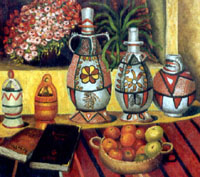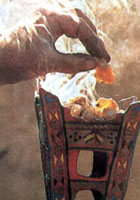
Yemen: Claiming the futurePart I in a series [Archives:2004/751/Culture]
July 1 2004
 |
 |
 |
[email protected]
For the Yemen Times
In the first part of the serialization of her essay 'Yemen: claiming the future', Irena Knehtl provides an historical perspective on economic development in Yemen and the Arab world.
Sanaa was born in September so as to die in November hen to be born again in May or in October.
Do you know how this dead Sanaa died?
And when it will live again?
Like an apricot tree it died standing.
So as to prepare for its green birth.
It continues to die so as to live better.
Abdalla Baraduni, Yemeni poet
Economics is about everyday life, and development is about people, their hopes and dreams, how to make difference and stand by the world. The challenge is to follow through and nurture the abundance that has a life of its own.
Human creativity cannot be measured in numbers and or statistics only. But if released it is the most important vehicle for human development.
The Arab Peninsula
The inhospitable, inaccessible area we know as the Arabian Peninsula can justify the claim to be the cradle of civilization. Its very inhospitability meant that within the limits of available technology it could support no more than a limited number of people. When that number was exceeded migration became inevitable. The migration, however, of peoples who were accustomed to fighting and struggling for their existence in a harsh environment and made a considerable impact on their new, less austere, surroundings.
The inhabitants of the peninsula had, for as long as can be remembered, referred to it as “Jazirat al-Arab”, the Island of the Arabs. The tribe of Kinda with its origin in mountainous Hadramawt in Yemen played a decisive role in cultural history of the Arabian Peninsula in the 5th and 6th centuries A.D. This was the tribe to which the famous Amra Al-Qais belonged, the greatest poet of pre-Islamic Arabia. It was under the impetus of the latter and of the Kinda that the Arabs were united for a century, and that Arabic developed a more united form – the language of the entire community. It also meant the first step towards unification that reached its heights with advent of Islam. From the womb of the Arab Peninsula gushed forth a spiritual force that carried the bounds of the Arab lands to five million square miles, one-eleventh of world's surface, and accounted for one thirtieth of mankind. It was the Islamic impetus that carried the Arabs from their home to historic greatness, and it was the Arabs who gave Islam its earthly success.
When after their long journey, the Banu Hilal, the tribe of tribes, whose origin is probably between ancient Marib and the Barati mountains, shook off the dust from their boots. The dust piled up and became the hill known after them. This dust also became covered with seeds that grew into trees in whose broad branches birds sang about faraway lands: the Arab Empire stretched from Persia in the east and to Spain and Morocco in the west
Yemen – The Setting
Secluded behind its mountain barriers, protected by its sheer lack of physical communication, Yemen maintained a reputation for mystery – even for Arabia. But Yemen has not always been isolated from the outside world. Unlike Oman, it is one of the few regions of the Peninsula to have regular rainfall. The soil is therefore fertile and valleys are green. Yemen was renowned for its walled cities, fruit gardens, spices, textiles, coffee, and cotton. To the Romans with its flourishing agriculture Yemen was Arabia Felix, or Happy Arabia.
History of Economic Development
Yemen has a long history of civilization and economic development. It has experienced several kingdoms and states through its long history.
The first kingdoms historically documented as political units were Maineans Sabeans, and Himyars which during the eight century B.C. existed simultaneously for 500 to 500 years. At height of their power they dominated much of Southern Arabia and controlled the incense trail.
In addition Marib held a commanding position for the transportation of frankincense on the important caravan route that ran from the areas on the Indian Ocean to the shores of the Mediterranean. The route wound along a chain of watering places on the edge of wadis, between the mountains and the desert. Here the riches of Arabia traveled by caravan through the Yemeni landscape. Herbs, spices, and incense were coveted throughout the ancient world. More than 3.000 tons may have been exported annually to Greece and Rome. It used to be giant industry. The whole civilized world craved incense and South Arabia controlled the source. It developed a powerful cartel, a kind of OPEC of its time. The “pipeline” began at Qana, the present day Birr Ali, east of Aden. During the Middle Ages, Al-Mukalla, replaced Qana as the chief port of Hadramawt.
There rose a river of incense that in ancient times flowed north in caravans from Arabia Felix – Happy Arabia – to distant Greece and Rome. Along the route a succession of kingdoms prospered for nearly two millennia: fabled names like Main, Hadramawt, Sheba, Qataban. They forged their own languages and alphabets, laws, and religious art and architecture, and engineered dams to farm hundreds of thousands of acres of desert before slipping into the dust of history.
Ancient Marib was the largest of the incense cities. The ancient Marib dam was built to harness runoff water from the high Yemeni mountains to the west. The dam and its canal network irrigated thousand of acres around the ancient Sabean capital. Upstream from the ancient site of the dam is the new dam. The new dam is meant to double the area the ancients used to cultivate and also make electricity.
Flourishing agricultural activity supported prosperous trade. The agricultural system reflected its owners' high skill, as demonstrated by the terraced fields and dams. Beside the incense route are high mountains and cool fertile valleys to the west, what perhaps was Saba's fairest province, and where majority of Yemenis live today. There coffee beans ripened on the green slopes. Yemen invented the beverage that took Europe by storm in the 1600s. The richest variety grew on Yemeni hills, although it took its name from the Yemeni seaport Mocha.
In the sixth century, however, the great Marib Dam, on which much of Yemeni farming was based, broke down. The wadis and forests disappeared, and Yemen entered a period of a long and slow decline. Further discovery of the sea route around Africa shifted most of the traditional trade from the incense trail.
The ruling dynasty of royal Imams which was to last for eleven hundred years, was founded in the ninth century. The following social, political and economic isolation prolonged economic stagnation and prevented initiatives for economic growth and development. The 26th September 1962 and subsequent 14th October 1967 Yemeni revolutions meant the most radical change experienced to date in the social, economic, political and cultural life on the Arab Peninsula.
Economic Development during the Eighties
Important structural changes took place during eighties in the area of trade, payments, investments and capital flows resulting in the formulation of a Yemeni national economic policy. Two main issues dominated the economies of the Arab Peninsula, namely food and energy. It was also during the eighties that the trend 'less food for more people' emerged. On the other hand the Arabian Peninsula emerged for industrial countries an important market. The region itself was very much on the crossroad.
A new division came into being:
The Arab Rich with material financial resources but no physical wealth, such as human resources, agricultural land, and rain water; and
Arab Poor with limited financial resources but physical resources, such as human resources, agricultural land, rain water.
The Arab rich cover their food requirements out of their petrol profits from imports from non-Arab countries. Further Arab speaking peoples depend on rivers and water flowing from non-Arab countries. Many Arab countries tap ground water. This may be a justified use for now but cannot continue indefinitely. Local drainage, flood control and river training facilities should be incorporated within the responsibilities of an irrigation scheme or urban or regional utilities.
The majority of Arabs live in poor Arab lands. Southern Arabia is the most populous part of the Arabian Peninsula. The social differences and challenges here are sharper. Their development is being further handicapped by different factors, such as lack of financial resources, education, poor technology, poor development policies and uncoordinated pan-Arab policy.
——
[archive-e:751-v:13-y:2004-d:2004-07-01-p:culture]


